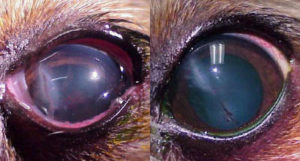ARTICLES
WHEN PUPPY MEETS KITTEN
Published Monday, December 15, 2014

December is a month filled with many celebrations and much holiday cheer. It is also a month that sees many new pets introduced into new loving homes. Most of the time this introduction is a joyous occasion for all involved. In the ophthalmology field, however, we see dogs and cats after things have not gone as planned. So if things go wrong it’s probably the dog’s fault right?
Well, the dog may be the instigator but the cat often causes the most damage when were talking about the eye. Cat claws are very sharp and a cat’s aim is very accurate. Often times, cats will scratch the cornea of their adversary whether it be a new dog or a new cat. A corneal laceration is serious business and often requires surgery to repair the wound. From an ophthalmology stand point, we worry that the claw may not just slice the cornea but may also come in contact with a structure called the lens. The lens is a clear structure inside the eye responsible for accommodation or maintaining a clear image on an object as the object’s distance varies. The lens is also where cataracts occur. If the shell or capsule around the lens is damaged by the cat claw, severe inflammation and cataract formation will ensue. Depending on the case, cataract surgery may accompany the corneal wound repair so that the patient is able to maintain a visual and comfortable eye. If a cat scratch to the eye is suspected, it is best to have your pet evaluated by a veterinarian immediately.
So now that we know the risks, how should we go about introducing the new ball of fur into the household?
- First of all, make sure all the cat’s nails are trimmed!
- Don’t leave the newly introduced pets alone together until you are very sure they get along. Letting them “work it out” themselves is dangerous for all parties involved.
- Often, letting the two pets smell and hear each other through a closed door allows for a stress free introduction for both parties. It’s best to keep them separate for several days.
- Let the cat set the pace. Introductions can potentially take weeks. If the cat wants to run and hide it is best to let them do so. Never attempt to force the interaction by holding the kitty or putting the cat in a crate. This will just increase stress.
- Once the cat no longer seems afraid or concerned about its new housemate, allow the two to meet in a larger space. Make sure that the cat can retreat from the situation and the room if she desires. It is best to keep the dog on a leash so that you keep him from chasing the cat.
- When the dog no longer seems interested in the cat, you can let him off the leash and allow the two to mingle.
- Many dogs and cats become the best of friends especially if we take care to introduce them properly!
December 2nd was National Mutt Day, so go out and find that fluffy, furry friend at one of the local shelters or rescue organizations that is in desperate need of a loving home. Introduce them properly to your household and everyone will have a happy holiday season!
Happy Holidays from South Texas Veterinary Ophthalmology!
 Located in the SAVS Facility
Located in the SAVS Facility
